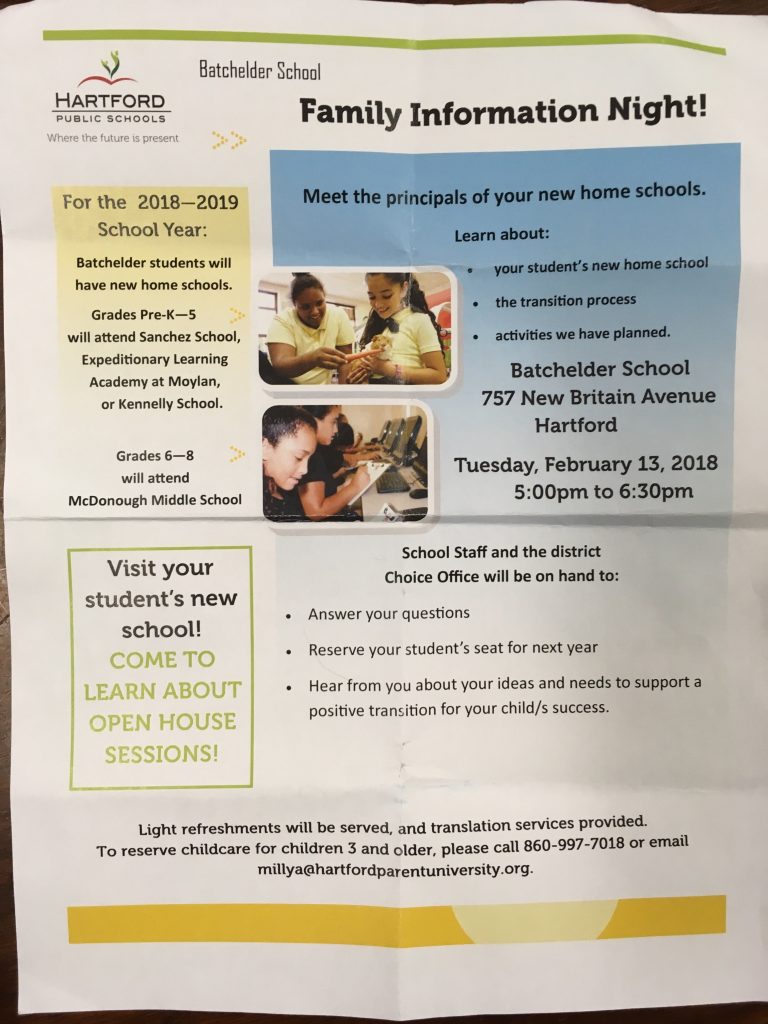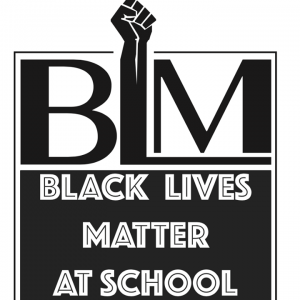Yesterday, I wrote about parents at Montessori Magnet (and other groups) using their power with the Hartford school district to take away a school building from Batchelder parents and students. Today, the district and one of the groups associated with the effort to take Batchelder will be at the school trying to convince parents to “choose” another school. The repackaging of removal and dispossession into school “choice” raises a number of questions.
What’s the background on this story?
To quickly recap, a few weeks ago the Hartford Board of Education voted to close Batchelder and a number of other schools. The officially declared purpose was to save money and re-invest in all schools. However, the data on this simply does not add up. Instead, in the case of Batchelder, the vote to close the school was actually a vote to take the school and give the building to Montessori Magnet parents, teachers, and students, all groups with more formal power.
What are the possible paths the Batchelder parents could take?
In the face of this removal and dispossession, the Batchelder parents have a number of possible paths. They could protest the move and take their fight to remain at the school to the Mayor of Hartford, who is also running a campaign for Governor of Connecticut, and his five appointees on the school board that form a majority and, in effect, control the Hartford Public Schools. They could decide to attend a desegregated magnet school run by HPS or leave the school district and attend schools through CREC or Open Choice, or even a privately-managed charter school. They could homeschool or attend a private school if that was their decision. Or they could choose to do nothing and the district would have to assign them a new school.
What is the school district selling Batchelder parents?
But that’s not what the school district is selling them. Instead, the school district, in collaboration with Hartford Parent University, an HPS contractor that lobbied heavily for this plan to happen, is repackagining parents’ removal from Bathelder into “choice” of a limited set of options.
On paper, the meeting tonight (February 13) at Batchelder school from 5-6:30 p.m. is being advertised as a “family information night”. The flyer (see below) says that parents can meet principals of their new “home” schools (not Batchelder, of course) and learn about these schools, the transition process, and “activities we have planned.” It goes on to say that school staff and the district choice office will attend to answer questions, “reserve your student’s seat next year”, and hear from you about your ideas and needs to support a positive transition for your child’s success.” The three schools listed as new “home” schools are Sanchez, Moylan, Kenelly, or McDonough Middle. The premise of the event is that parents now have a chance to “choose” their new school.
Isn’t that so empowering?
What questions does this event raise?
There’s a number of questions that this flyer raises. When the Board announced it would close Batchelder and give the school to Montessori, parents opposed the “closure” and requested information about why it was closed. As of this writing, parents (or teachers) have not received an written notification or justification as to why their school might close and be given away to another, more powerful group of parents. Before the Board’s vote, parents wanted information and they wanted their ideas to be heard. Why only now, after the school is set to taken away from them, are their “ideas and needs” considered?
Based on the video of public hearings, the Batchelder parents choice is to stay at Batchelder and continue at the school as it is. It was very clear that the community was unified in wanting to stay at the school and not see the building go to Montessori Magnet. Why is staying at Batchelder, their first choice, not on this list?
In reality, parents do not have to make any school choice selections. If they don’t make any selections and the District moves forward with removal, by policy and custom, the school district would simply place these students in the same four schools listed above. By convincing parents to actively “choose” by filling out a local choice application to attend schools that would otherwise be the default schools raises concerns. If voting to close the school is not enough, the district will empty out the school through a “school choice” process that induces anxiety amongst parents to find a new school. Once parents “choose” these other schools, will we be told that parents “want” to leave Batchelder?
As a result of the State’s settlement of the Sheff v. O’Neill (1996) case, parents can choose to attend desegregated schools, and in this case, that means magnet schools or the Open Choice program. However, this flyer only tells parents that their “home” school is one of four racially segregated schools, never mentioning the full list of magnet, non-magnet, or other options available to parents. While these schools may be appealing to parents and present different options, they are neither Batchelder parents preferred path of staying at Batchelder, nor all the options available to them. In fact, there are a handful of magnet options nearby as well, including Breakthrough and Mary Hooker magnet schools.
Batchelder parents and students are being removed and dispossessed in order to give Montessori Magnet parents and students the Batchelder building. For Batchelder parents, Montessori Magnet, a numerically desegregated school, is never listed as a possible option on this flyer despite the fact it will be within walking distance for at least 100 current Batchelder students. Batchelder is an example of mostly Latino school that is working for its students and parents. But the district intends to dismantle the school, then compel parents to “choose” more racially isolated schools. By excluding all of the relevant information about desegregated schools, is this event a form of steering to racially segregated district schools?
What do you think?



